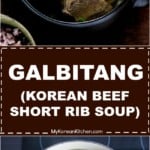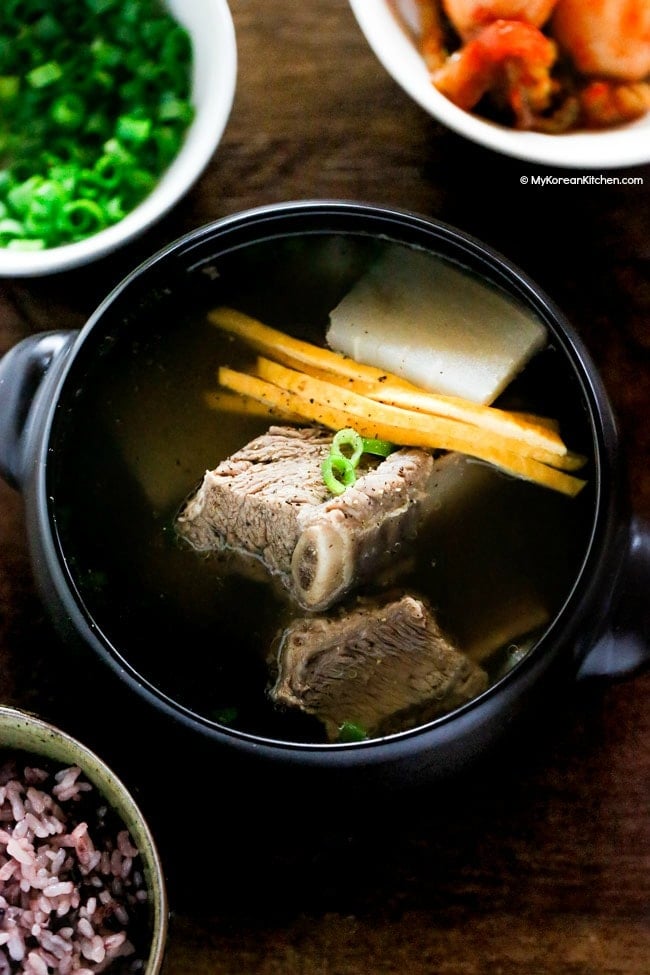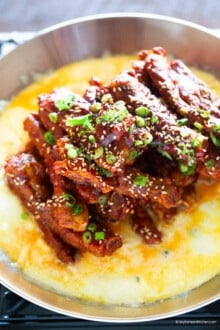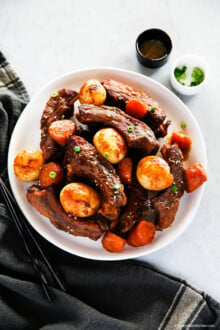Try this hearty and heartwarming Korean beef short rib soup – galbitang at home.
Short ribs are slowly simmered for over 1 hour to bring out all the good nutrients, making it a particularly great soup when you feel run down. Most importantly though, it is delicious, with delicate flavor and is filling, so it will hit the spot of many!
What is Galbitang
Galbitang or galbi-tang (갈비탕) is Korean soup made with beef short ribs. Flavorful beef short ribs are simmered for over 1 hour among other aromatic vegetables (e.g. radishes, green onions, garlic and so on) and herbs. The result is deep, rich savory tasting soup with tender beef ribs.
Galbitang is known as a stamina food in Korea. It’s particularly a perfect soup to have when your body feels under the weather. I always feel more energized after having this soup. Some people even add ginseng, dried jujube and chestnuts to make it extra healthy, though I haven’t tried it this way as I like it classic style.
It used to be served at a wedding receptions many years ago, but nowadays you won’t see it as often, as serving buffet meals has gained more popularity.
Tips
I want to highlight two things that I think are important or handy in making this soup.
- Soy Sauce
One of the key ingredients in this recipe is soy sauce and I recommend you use Korean soup soy sauce (I used this one) if you can get it. Korean soup soy sauce is known to be lighter in color and saltier in taste compared to a regular soy sauce.
Though, if you can’t find Korean soup soy sauce, a good alternative is Kikkoman brand regular soy sauce. Although it may give you a bit stronger soy sauce smell initially, after a while that smell will disappear and it will give you about the same tasting soup.
- Disposable Fat Skimming Sheets
Beef short ribs are a fairly fatty part of beef cuts and the soup will certainly contain that fat unless you skim it.
I bought a pack of fat skimming sheets (picture below) from my local Daiso a few months back and it came in very handy for removing fat from the broth.
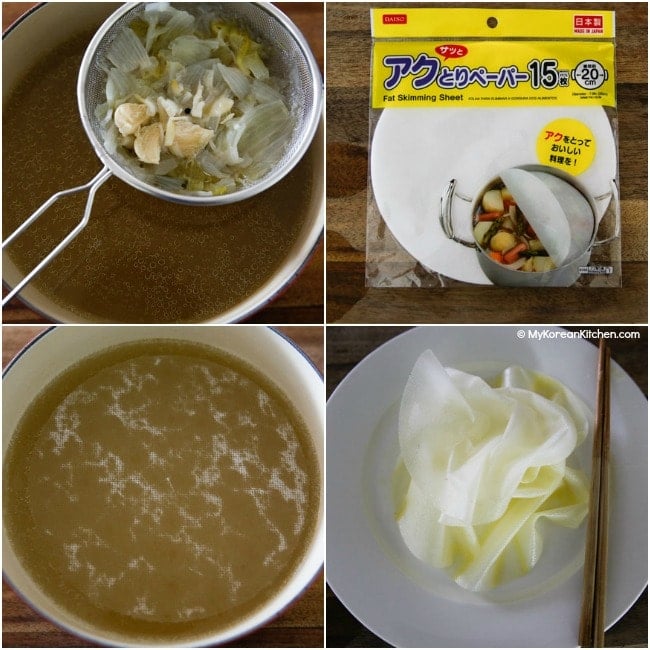
I had to use about 3 sheets in total (one sheet at a time) before I added back the seasoned short ribs and sliced radishes (just before step 4 in the recipe below) and it literally took most of the floating fat. I also really loved the fact that I can just discard the sheets after use as they are disposable.
If you can’t get this, you could try using cheese cloth or solidify the fat overnight in the fridge. By removing the fat, you really can appreciate the delicate flavor of galbitang even more.
P.S. Do you love beef short ribs? If so, try these! Slow Cooker Korean Short Ribs and Galbi Jjim (Korean Braised Short Ribs)
Ingredients for Galbitang (4 – 6 Servings)
Main
- 1.2 kg – 1.4 kg / 2.6 pounds – 3 pounds beef short ribs, membranes removed
- 1 onion (200g / 7 ounces), cut into large chunks
- 250g / 9 ounces Korean radish (or daikon radish), peeled
- 60g / 2 ounces green onions, white part
- 30g / 1 ounce garlic, peeled
- 10 whole black peppers
- 10 cups water
- 25g / 1 ounce green onions, thinly sliced
- (optional) 70g / 2.5 ounces Korean glass noodles (dangmyeon)
Seasonings
- 1.5 Tbsp Korean soup soy sauce or regular kikkoman soy sauce
- 1 Tbsp minced garlic
- 2 tsp fine sea salt, or more to taste
- ground black peppers, to taste
Garnish
- (optional) 2 eggs, egg white and yolk separated and cooked over medium low heat, thinly sliced
* 1 Tbsp = 15 ml, 1 Cup = 250 ml
** If you want to learn more about Korean ingredients, check my essential Korean ingredients list.
How to Make Galbitang
1. Soak the beef ribs in cold water for 20 mins. Change the water a few times during this time. This is to draw out the red liquid (which looks like blood) from the meat and also to rinse out any bone fragments.
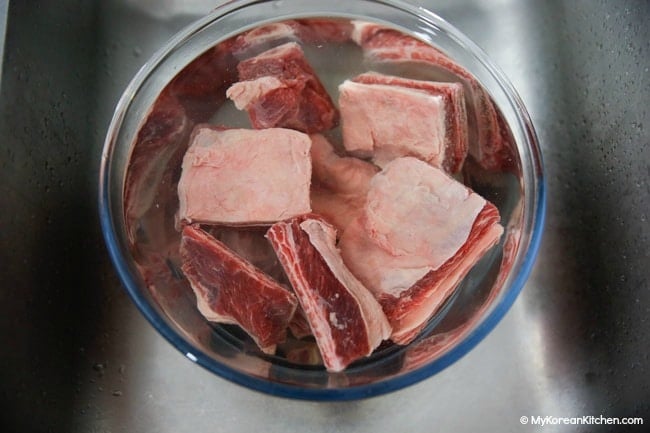
2. In a large pot of rolling boiling water (enough to fully cover the ribs), boil the ribs for 6 to 8 minutes over medium high heat. Drain the water and rinse the ribs in cold water. Cut off any obvious excess fat from the ribs.
Place them in a large clean pot. Add onions, radish, green onions, garlic, black peppers, and water (10 cups) into the pot and bring them to boil over medium high heat, covered. Once rolling boiling, reduce the heat to medium low heat and simmer for 1.5 hours.
If adding, soak the glass noodles in a large bowl of cold water (fully immersed).
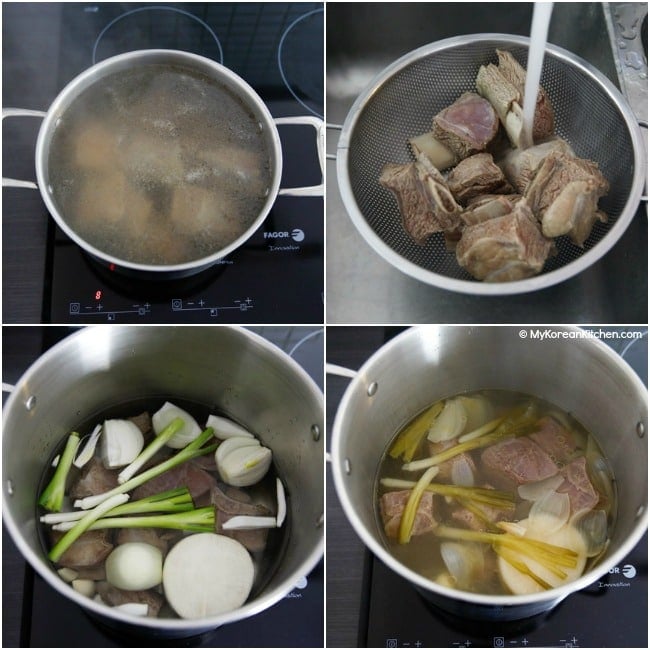
3. Gently take out the beef ribs and radish from the broth and set them aside. Strain the remaining ingredients over a large clean pot. Discard all the strained vegetables while keeping the broth. Remove the fat. (Refer to the tips mentioned above.) Thinly slice the radish and place them into the pot.
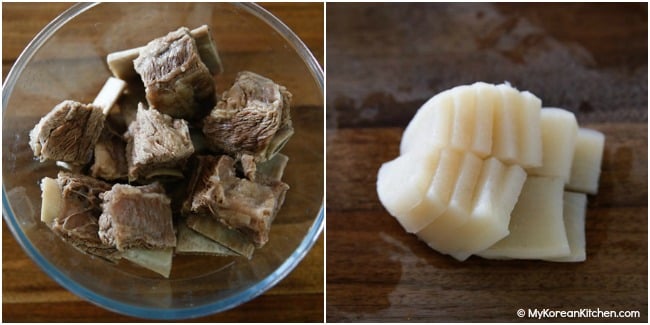
4. Season the beef ribs with the seasoning ingredients and gently place them into the pot. Bring the pot to boil over medium high heat for about 8 mins. Add the glass noodles and green onions and boil for a further 2 mins.
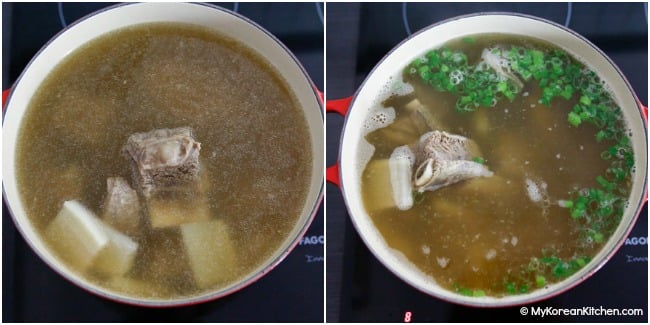
5. Serve the soup with cooked rice and other Korean side dishes (ie. radish kimchi and purple rice in the photo). If adding, garnish with julienned eggs (note that I only showed the cooked egg yolks in the photo, not the egg whites).

How to Store
Leftover soup can be refrigerated for 2 days in an airtight container. You can also freeze them for up to 1 month. When I store leftovers, I remove all the bones so it’s less bulky.
Another thing to note is glass noodles don’t store well as it changes shapes and texture. So I suggest you finish all the noodles at the initial serving if you added them.
Love Korean food? Browse my other Korean recipes from here. And subscribe to my newsletter and follow along on Facebook, Pinterest and Instagram for all of the latest updates.
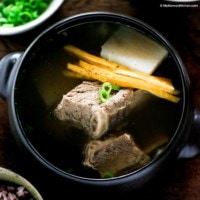
Galbitang (Korean Beef Short Rib Soup)
Ingredients
MAIN
- 1.2 - 1.4 kg beef short ribs (2.6 – 3 pounds), membranes removed
- 1 onion (200g / 7 ounces), cut into large chunks
- 250 g Korean radish (or daikon radish), peeled
- 60 g green onions (2 ounces), white part
- 30 g garlic (1 ounce), peeled
- 10 whole black peppers
- 10 cups water
- 25 g green onions (1 ounce), thinly sliced
- 70 g Korean glass noodles (2.5 ounces), optional
SEASONINGS
- 1.5 Tbsp Korean soup soy sauce or regular kikkoman soy sauce
- 1 Tbsp minced garlic
- 2 tsp fine sea salt , or more to taste
- ground black peppers , to taste
GARNISH
- 2 eggs (optional), egg white and yolk separated and cooked over medium low heat, thinly sliced
Instructions
- Soak the beef ribs in cold water for 20 mins. Change the water a few times during this time. This is to draw out the red liquid (which looks like blood) from the meat and also to rinse out any bone fragments.
- In a large pot of rolling boiling water (enough to fully cover the ribs), boil the ribs for 6 to 8 minutes over medium high heat. Drain the water and rinse the ribs in cold water. Cut off any obvious excess fat from the ribs.Place them in a large clean pot. Add onions, radish, green onions, garlic, black peppers, and water (10 cups) into the pot and bring them to boil over medium high heat, covered. Once rolling boiling, reduce the heat to medium low heat and simmer for 1.5 hours.If adding, soak the glass noodles in a large bowl of cold water (fully immersed).
- Gently take out the beef ribs and radish from the broth and set them aside. Strain the remaining ingredients over a large clean pot. Discard all the strained vegetables while keeping the broth. Remove the fat. (Refer to the tips mentioned above.) Thinly slice the radish and place them into the pot.
- Season the beef ribs with the seasoning ingredients and gently place them into the pot. Bring the pot to boil over medium high heat for about 8 mins. Add the glass noodles and green onions and boil for a further 2 mins.
- Serve the soup with cooked rice and other Korean side dishes (ie. radish kimchi and purple rice in the photo). If adding, garnish with julienned eggs (note that I only showed the cooked egg yolks in the photo, not the egg whites).
Notes
Nutrition Info (per serving)
The nutrition information shown is an estimate provided by an online nutrition calculator. It should not be considered a substitute for a professional nutritionist’s advice.
